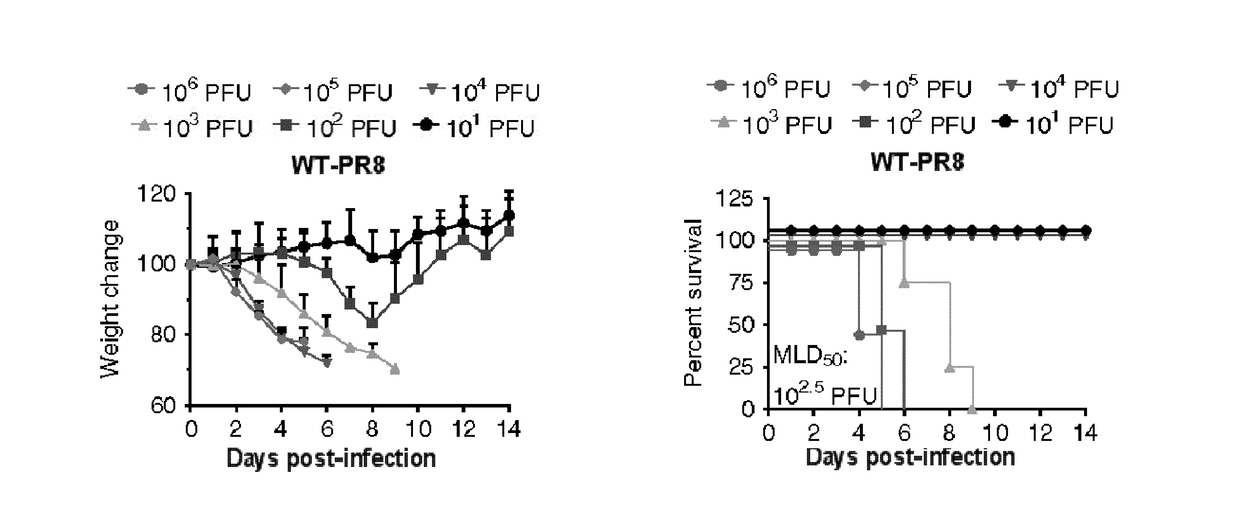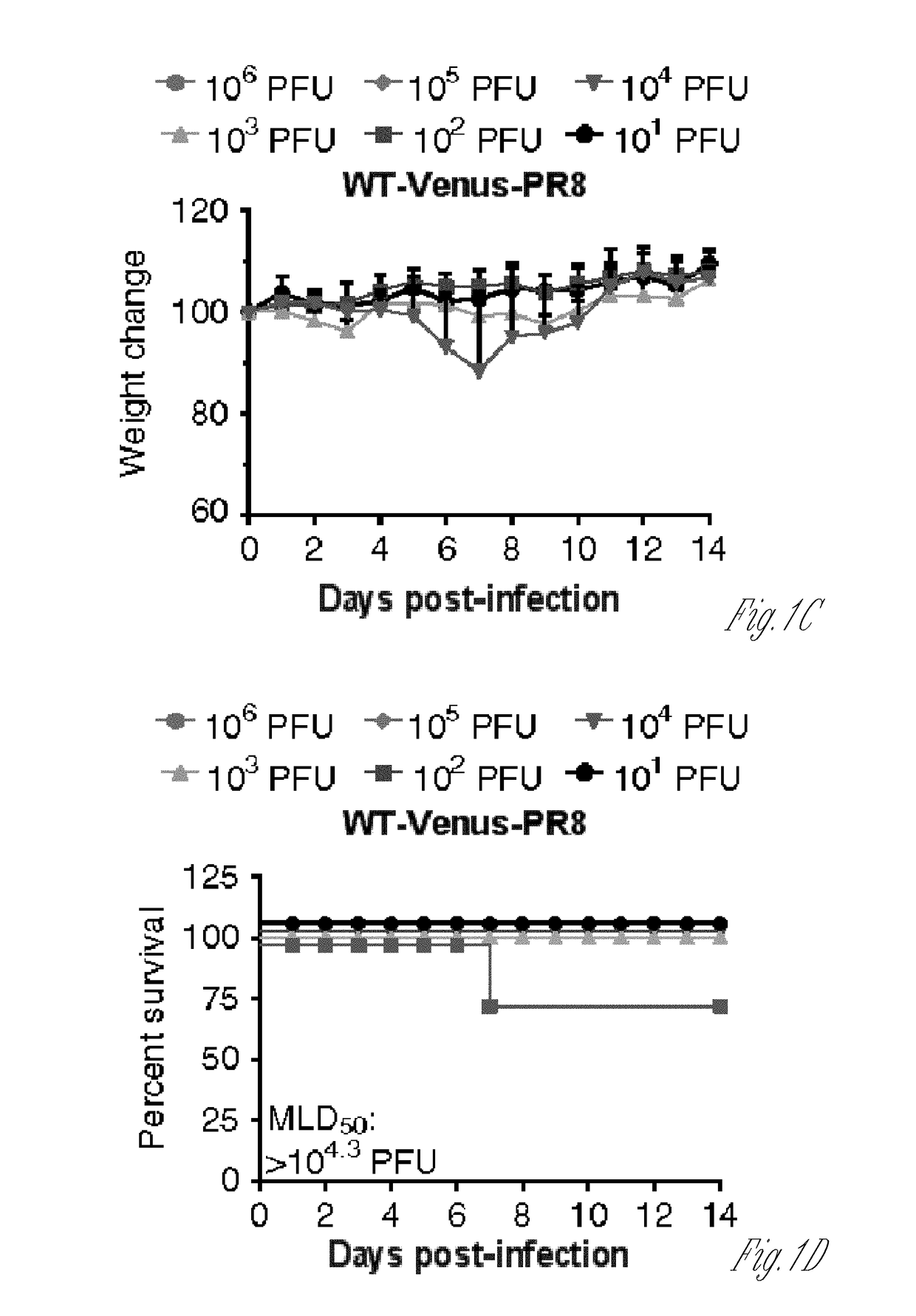Mutations that confer genetic stability to additional genes in influenza viruses
a technology of influenza viruses and mutations, applied in the field of respiratory pathogens, can solve the problems of significantly attenuated viruses, inaccurate reflection of natural, and insufficient understanding of influenza virus-induced pathology, and achieve the effect of enhancing the stability of influenza viruses and increasing genetic stability
- Summary
- Abstract
- Description
- Claims
- Application Information
AI Technical Summary
Benefits of technology
Problems solved by technology
Method used
Image
Examples
example i
Method
Generation of Color-Flu
[0110]The NS segments of PR8 fused with different fluorescent reporter genes including eCFP, eGFP, Venus, and mCherry were constructed by overlapping fusion PCR as described in Manicassamy et al. (2010). In brief, the open reading frame (ORF) of the NS1 gene without the stop codon was fused with the N-terminus of fluorescent reporter genes via a sequence encoding the amino acid linker GSGG. The fluorescent reporter ORFs were followed by a sequence encoding the GSG linker, a foot-and-mouth virus protease 2A autoproteolytic site with 57 nucleotides from porcine teschovirus-1 in Manicassamy et al. (2010), and by the ORF of nuclear export protein (NEP) (FIG. 5). In addition, silent mutations were introduced into the endogenous splice acceptor site of the NS1 gene to abrogate splicing (Basler et al., 2001). The constructed NS segments (designated eCFP-NS, eGFP-NS, Venus-NS, and mCherry-NS) were subsequently cloned into a pPoll vector for reverse genetics as d...
example ii
[0133]As disclosed in Example I, an H5N1 virus with the Venus (Nagai et al., 2002) (a variant of eGFP; ref) reporter gene (designated wild-type Venus-H5N1 virus, and abbreviated as WT-Venus-H5N1 virus) was prepared using reverse genetics; this virus showed moderate virulence and low Venus expression in mice. After six passages in mice a mouse-adapted Venus-H5N1 virus was acquired (abbreviated as MA-Venus-H5N1 virus) that stably expressed high levels of Venus in vivo and was lethal to mice; a dose required to kill 50% of infected mice (MLD50) was 3.2 plaque-forming units (PFU), while that of its parent WT-Venus-H5N1 virus was 103 PFU. However, the mechanism for this difference in virulence and Venus stability was unclear.
[0134]In this study, the molecular mechanism that determines the virulence and Venus stability of Venus-H5N1 virus in mice was explored. By using reverse genetics, various reassortants between WT-Venus-H5N1 and MA-Venus-H5N1 virus were rescued and their virulence in ...
example iii
Materials and Methods
[0178]Cells and Viruses.
[0179]Madin-Darby canine kidney (MDCK) cells were maintained in minimum essential medium (MEM) containing 5% of newborn calf serum (NCS). Human embryonic kidney 293T (HEK293T) and HEK293 cells were maintained in Dulbecco's modified Eagle medium supplemented with 10% fetal calf serum (FCS). A / Puerto Rico / 8 / 34 (H1N1; PR8) (Horimoto et al., 2007) and each NS1-Venus PR8 virus were generated by using reverse genetics and were propagated in MDCK cells at 37° C. for 48 hours in MEM containing L-(tosylamido-2-phenyl) ethyl chloromethyl ketone (TPCK)-treated trypsin (0.8 μg / mL) and 0.3% bovine serum albumin (BSA) (Sigma Aldrich).
[0180]Adaptation of NS1-Venus PR8 Virus in Mice.
[0181]Six- to eight-week-old female C57BL / 6 mice (Japan SLC) were intranasally infected with 50 μL of 2.3×106 plaque-forming units (PFU) of NS1-Venus PR8 virus. Lungs were harvested 3-6 days post-infection (dpi) and homogenized in 1 mL of phosphate-buffered saline (PBS). To o...
PUM
| Property | Measurement | Unit |
|---|---|---|
| volume | aaaaa | aaaaa |
| wavelength | aaaaa | aaaaa |
| total volume | aaaaa | aaaaa |
Abstract
Description
Claims
Application Information
 Login to View More
Login to View More - R&D
- Intellectual Property
- Life Sciences
- Materials
- Tech Scout
- Unparalleled Data Quality
- Higher Quality Content
- 60% Fewer Hallucinations
Browse by: Latest US Patents, China's latest patents, Technical Efficacy Thesaurus, Application Domain, Technology Topic, Popular Technical Reports.
© 2025 PatSnap. All rights reserved.Legal|Privacy policy|Modern Slavery Act Transparency Statement|Sitemap|About US| Contact US: help@patsnap.com



